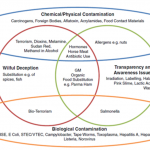One stringent component of FSMA and the Final Rule on Sanitary Transportation of Human and Animal Food is record keeping. Depending on the type and size of business, the FDA can demand proof of record anywhere from under one year and upwards to two years, all while needing to address their inquiry within 24 hours. Failure to do so will be considered a “prohibited act” and violators can be tried for civil and criminal penalties.
This new rule, put in place by the FDA, will put immense pressure on the food transportation industry, not only to make food safety a priority, but also to ensure that proper food safety practices and measures are being properly implemented, by way of record keeping.
While the litany of rules and regulations pertaining to record keeping best practices is intense, let us break down the basic requirements applying to records in layman’s terms:
- If HACCP procedures aren’t documented, it didn’t happen
- Records must be verbatim accounts of what happened
- The need for real-time recording is paramount
- Corrective actions must be executed immediately if an issue occurs
- If not, liability risk increases exponentially
Companies must determine the most efficient and plausible manner by which they will comply. Traditional storage of records in filing cabinets and input of data in spreadsheets is antiquated, and leads to errors and the potential for misplaced records. Now, more than ever, is the time for businesses along the food chain to deliver value to their organization via digital technologies and automated data gathering solutions. This will ensure constant visibility and ensure quality control throughout the process from farm to fork.
Where Does Waste Happen?
While covering a lettuce farm in central California, National Geographic discovered that numerous loads were dumped each day due to procedural mistakes , including improperly filled, labeled and sealed containers.1 Due to the mishaps, the loads were then dumped. Between April and November that year, the local Waste Authority landfilled 4–8 million pounds of fresh vegetables from those fields.
The Food and Agriculture Organization (FAO) estimates that:
- 54% of world food waste occurs during production, handling and storage
- 46% occurs during processing & distribution
These numbers are not only staggering, but they illustrate the seriousness of this issue.
Many of these mishaps occur when standard recording procedures are done manually, which leads to improper documentation that invalidates the integrity of shipments—to which the above figures illustrate and corroborate.
But can shippers, loaders, receivers and the like secure their procedures and eliminate wasted product by implementing stricter digital HACCP solutions?
Lost Food
While improper execution of best practices can lead to FDA imposed sanctions and profit loss, it also perpetuates the problem of food waste globally. This issue has become an epidemic and one that greatly affects the lives of many.
In a recent National Geographic article, The Food and Agriculture Organization (FAO) suggests the following:1
- One-third of food produced for global human consumption is annually lost or wasted along the supply chain
- Food waste equates to 2.8 trillion pounds each year, which is enough to feed 3 billion people per year
Consider this: The World Food Programme estimates that nearly 795 million people in the world do not have access to the proper amount of food needed to live a healthy, active life, which equates to roughly one in nine people on earth.
The amount of waste created along the supply chain each year is enough to feed the hungry and malnourished people of the world three-times over. While waste is inevitable, even a 50% improvement would be able to feed those most in need.
We understand the nature of business is overcoming competition while expending the least capital possible, ultimately leading to profit. However, food-related businesses along the supply chain must ask themselves whether or not they are their own competition. Are best practices being properly executed? How can they ensure this in order to mitigate waste?
Ultimately, however, it becomes a human issue. Companies must be responsible and possess the empathy to understand this. While domestically we may not feel the effects of global hunger as much as other third-world countries, these businesses must be aware of the epidemic in order to elucidate this topic while simultaneously maximizing its businesses potential.
By leveraging new food safety solutions such as mobile devices, the cloud, IoT, sensors and more, you can better protect your customers while also gaining a tangible ROI. Wherever consumers purchase and shop for food today, they are likely to find a larger selection than ever before. From the bread aisle to the cheese counter to the produce section, food options and manufacturing processes today are more diverse than ever. While variety is positive on a consumer and cultural level, it can create challenges for food safety from farm to fork.
Reference
- Royte, E. (October 13, 2014). “One-Third of Food Is Lost or Wasted: What Can Be Done”. National Geographic. Retrieved from http://news.nationalgeographic.com/news/2014/10/141013-food-waste-national-security-environment-science-ngfood/.








